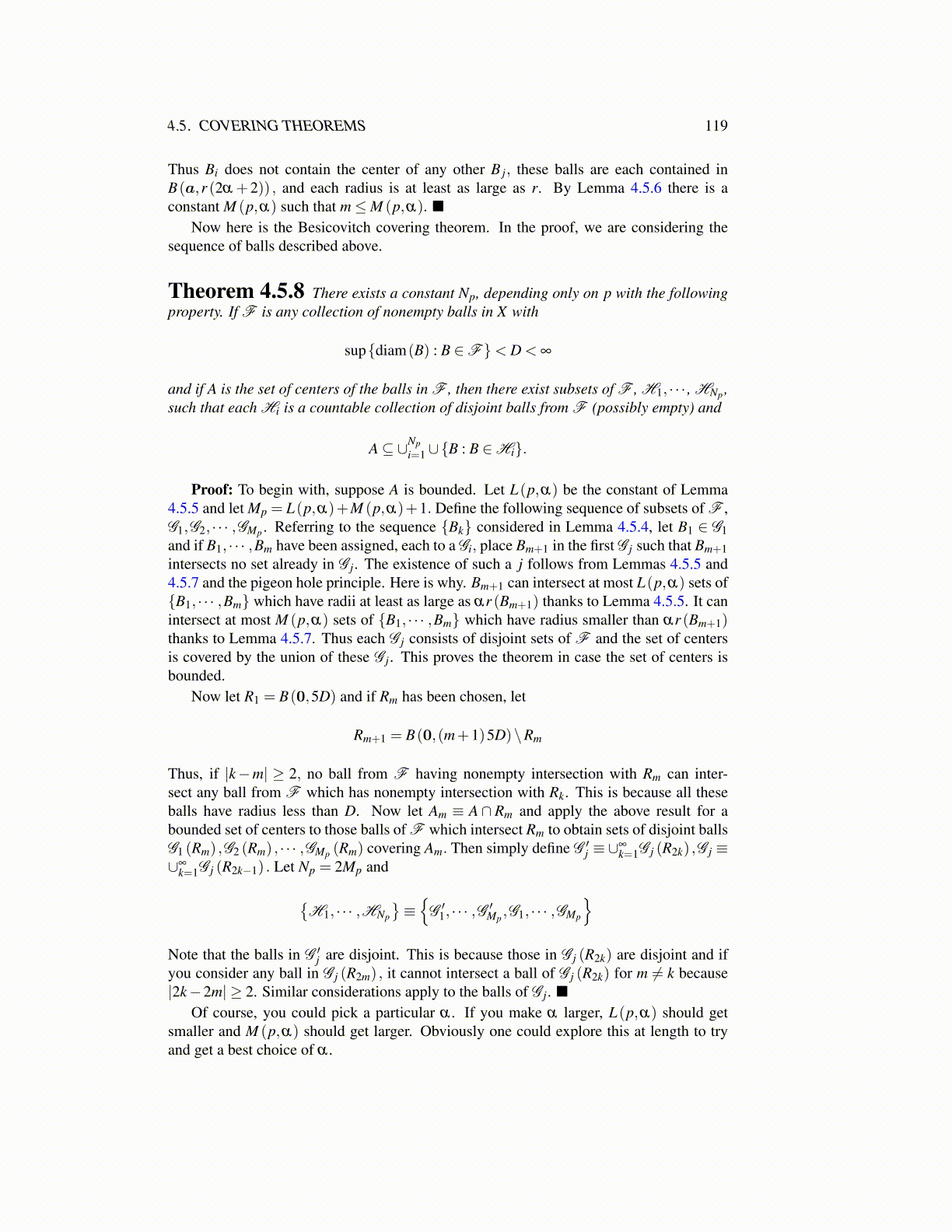
4.5. COVERING THEOREMS 119
Thus Bi does not contain the center of any other B j, these balls are each contained inB(a,r (2α +2)) , and each radius is at least as large as r. By Lemma 4.5.6 there is aconstant M (p,α) such that m≤M (p,α). ■
Now here is the Besicovitch covering theorem. In the proof, we are considering thesequence of balls described above.
Theorem 4.5.8 There exists a constant Np, depending only on p with the followingproperty. If F is any collection of nonempty balls in X with
sup{diam(B) : B ∈F}< D < ∞
and if A is the set of centers of the balls in F , then there exist subsets of F , H1, · · · , HNp ,such that each Hi is a countable collection of disjoint balls from F (possibly empty) and
A⊆ ∪Npi=1∪{B : B ∈Hi}.
Proof: To begin with, suppose A is bounded. Let L(p,α) be the constant of Lemma4.5.5 and let Mp = L(p,α)+M (p,α)+1. Define the following sequence of subsets of F ,G1,G2, · · · ,GMp . Referring to the sequence {Bk} considered in Lemma 4.5.4, let B1 ∈ G1and if B1, · · · ,Bm have been assigned, each to a Gi, place Bm+1 in the first G j such that Bm+1intersects no set already in G j. The existence of such a j follows from Lemmas 4.5.5 and4.5.7 and the pigeon hole principle. Here is why. Bm+1 can intersect at most L(p,α) sets of{B1, · · · ,Bm} which have radii at least as large as αr (Bm+1) thanks to Lemma 4.5.5. It canintersect at most M (p,α) sets of {B1, · · · ,Bm} which have radius smaller than αr (Bm+1)thanks to Lemma 4.5.7. Thus each G j consists of disjoint sets of F and the set of centersis covered by the union of these G j. This proves the theorem in case the set of centers isbounded.
Now let R1 = B(0,5D) and if Rm has been chosen, let
Rm+1 = B(0,(m+1)5D)\Rm
Thus, if |k−m| ≥ 2, no ball from F having nonempty intersection with Rm can inter-sect any ball from F which has nonempty intersection with Rk. This is because all theseballs have radius less than D. Now let Am ≡ A∩ Rm and apply the above result for abounded set of centers to those balls of F which intersect Rm to obtain sets of disjoint ballsG1 (Rm) ,G2 (Rm) , · · · ,GMp (Rm) covering Am. Then simply define G ′j ≡∪∞
k=1G j (R2k) ,G j ≡∪∞
k=1G j (R2k−1) . Let Np = 2Mp and
{H1, · · · ,HNp
}≡{
G ′1, · · · ,G ′Mp ,G1, · · · ,GMp
}Note that the balls in G ′j are disjoint. This is because those in G j (R2k) are disjoint and ifyou consider any ball in G j (R2m) , it cannot intersect a ball of G j (R2k) for m ̸= k because|2k−2m| ≥ 2. Similar considerations apply to the balls of G j. ■
Of course, you could pick a particular α . If you make α larger, L(p,α) should getsmaller and M (p,α) should get larger. Obviously one could explore this at length to tryand get a best choice of α .